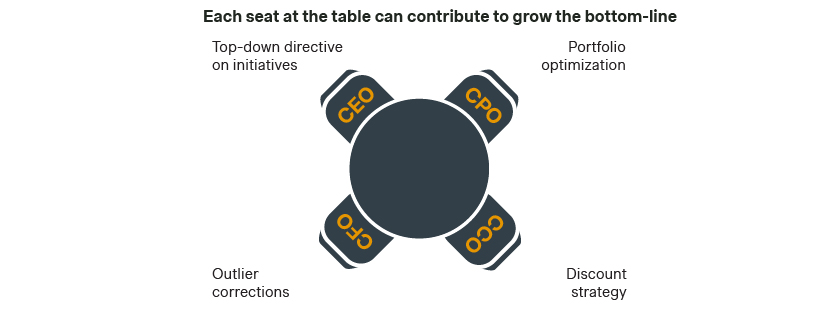Resilient organizations equip themselves with a relentless focus on margins. We share five fundamental measures to defend the bottom line that are often overlooked, which permit to increase profit margins even in times of growth uncertainty and restraints.
How to grow the bottom line in times of limited revenue growth?
The turbulence of market dynamics in the current year has compelled businesses to reassess their strategies for safeguarding their bottom line. The economic landscape has been characterized by unprecedented challenges, from global supply chain disruptions to shifting consumer behaviors. Severe changes in the political landscape have caused a level of uncomfortable economic stability, where growth is no longer guaranteed.
In our interactions with CEOs, we notice many companies have managed to pass through cost increases, although often with significant delay. Most organizations struggle in achieving pricing power and dictate price levels that are based on value, rather than cost fluctuations.

Looking ahead, it becomes imperative for businesses that the coming financial quarters will remain challenging. With many organizations aiming for low single digit revenue growth, leadership teams must position their companies strategically to secure future profits, while exercising prudent risk management. The answer lies in margin management: a careful examination of operational commercial strategies to unlock additional profit.
Measures to grow the bottom line
1. Portfolio optimization
One crucial step in protecting the bottom line is to conduct a thorough analysis of the service or product portfolio. Businesses must identify and prioritize offerings that align with current market demands and profitability. By streamlining the product or service portfolio, companies can focus resources on high-performing and strategically important areas, thereby optimizing operational efficiency and reducing costs. For example, reducing the breadth of the portfolio by discontinuing low margin products.
Secondly, optimizing the product mix involves strategically adjusting the offering towards higher margin products. By analyzing sales data and customer preferences, businesses can identify high-margin products or services and propose them proactively to their customers. This ensures a larger share of high margin sales. For example, analyzing cross-sell patterns to push high-margin products to specific customer segments.
2. Discounting rationalization
During the inflationary period, customers have gotten accustomed to price increases, combined with high discount levels and royal discounting policies. Even though discounting is typically used as lever to boost short-term results, our research shows most companies have excessive discount policies in place. In many of these cases, discounts are based on gutfeel and not based on performance. Recalibrating your promotional calendar and discounting policy with a fact-based strategy allows to prevent unnecessary margin leakage.
3. Surgical Outlier Repair
Addressing outliers in your business is crucial for protecting the bottom line. This involves identifying and rectifying underperforming segments or operations that may be draining resources without delivering proportional returns. A thorough review of processes, departments, or products that deviate significantly from the average performance can uncover opportunities for improvement.
4. Less Expensive Alternatives
In times of limited revenue growth, exploring and implementing less expensive alternatives without compromising quality is a strategic move. This may involve renegotiating supplier contracts, seeking cost-effective raw materials, reducing service levels, or identifying alternative production methods. By actively pursuing less expensive alternatives, businesses can better protect their volumes and improve overall financial health.
5. Digital Go-to-Market
The digital transformation has become an integral aspect of commercial strategy, and its importance has been amplified in the current market dynamics. Many organizations still do not fully leverage digital channels for marketing and sales. Not only to reduce operational costs but also enhance customer satisfaction and increase reach. Simon-Kucher's European Growth Study shows successful companies are ahead in implementing digital transformations compared to their less successful peers. Establishing a robust and differentiated online presence to all customer segments, utilizing e-commerce platforms, and optimizing digital marketing efforts can be instrumental in maintaining revenue streams and adapting to evolving consumer behaviors.
Looking ahead
As we look forward to the upcoming year, the commercial landscape remains uncertain, and businesses must remain agile to navigate through these challenges. Implementing measures such as portfolio optimization, exploring less expensive alternatives, conducting outlier repair, product mix optimization and embracing digital go-to-market strategies are crucial steps in protecting and growing the bottom line amidst limited revenue growth. By proactively addressing these aspects, businesses can position themselves for success in the dynamic markets of the future. As the tides of change continue to shape the business environment, the ability to adapt and innovate will be the key to commercial resilience and sustained profitability.

Call to action
All leadership roles play a part in margin management. CEOs need to establish a top-down directive on margin management initiatives as part of their profitability program. CFOs are to ensure performance reporting is in place and fed back to the leadership team. The financial teams are also responsible to spot areas for surgical outlier repair. CCOs are recommended to revisit their discounting structure and the digital go to market strategy, while CPOs are typically accountable for portfolio optimization and navigating towards less expensive alternatives.
Proven framework to manage for profit
To support business leaders to manage for profit in 2024, this whitepaper shares our proven framework with 6 commercial levers to boost profitability instantly. It offers actionable insights and strategies designed to address the distinct challenges found in both B2B and consumer industries. You can download the whitepaper to manage for profit here. Download it now and set the course for a prosperous tomorrow.








